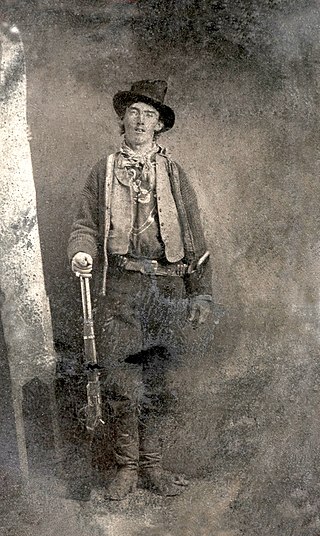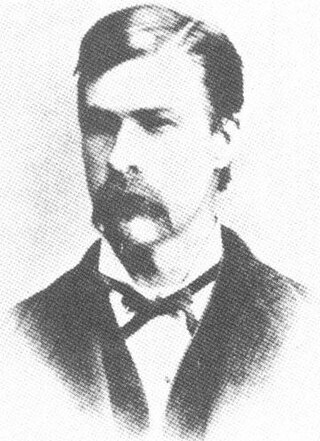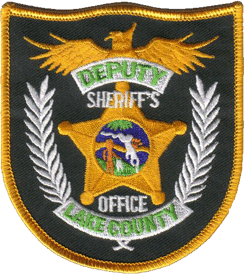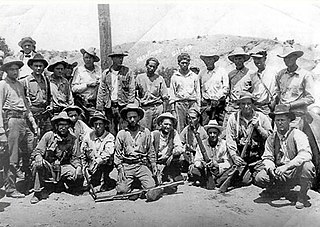
The Lincoln County War was an Old West conflict between rival factions which began in 1878 in Lincoln County, New Mexico Territory, the predecessor of the state of New Mexico, and continued until 1881. The feud became famous because of the participation of William H. Bonney. Other notable participants included Sheriff William J. Brady, cattle rancher John Chisum, lawyer and businessmen Alexander McSween, James Dolan and Lawrence Murphy.

Morgan Seth Earp was an American sheriff and lawman. He served as Tombstone, Arizona's Special Policeman when he helped his brothers Virgil and Wyatt, as well as Doc Holliday, confront the outlaw Cochise County Cowboys in the gunfight at the O.K. Corral on October 26, 1881. All three Earp brothers had been the target of repeated death threats made by the Cowboys who were upset by the Earps' interference in their illegal activities. The lawmen killed Cowboys Tom and Frank McLaury and Billy Clanton. All four lawmen were charged with murder by Billy's older brother, Ike Clanton, who had run from the gunfight. During a month-long preliminary hearing, Judge Wells Spicer exonerated the men, concluding they had been performing their duty.

The sacking of Lawrence occurred on May 21, 1856, when pro-slavery settlers, led by Douglas County Sheriff Samuel J. Jones, attacked and ransacked Lawrence, Kansas, a town that had been founded by anti-slavery settlers from Massachusetts who were hoping to make Kansas a free state. The incident fueled the irregular conflict in Kansas Territory that later became known as Bleeding Kansas.

The Earp Vendetta Ride was a deadly search by a federal posse led by Deputy U.S. Marshal Wyatt Earp for a loose confederation of outlaw "Cowboys" they believed had ambushed his brothers Virgil and Morgan Earp, maiming the former and killing the latter. The two Earp brothers had been attacked in retaliation for the deaths of three Cowboys in the Gunfight at the O.K. Corral on October 26, 1881. From March 20 to April 15, 1882, the federal posse searched southeast Cochise County, Arizona Territory for the men they believed were responsible for the attacks on Virgil and Morgan. Several suspects had been identified and were charged, but were soon released by the court, owing in some cases to legal technicalities and in others to the strength of alibis provided by the Cowboy gang. Wyatt subsequently pursued the suspects with a federal warrant.

WarrenBaxterEarp was an American frontiersman and lawman. He was the youngest of Earp brothers, Wyatt, Morgan, Virgil, James, and Newton Earp. Although he was not present during the Gunfight at the O.K. Corral, after Virgil was maimed in an ambush, Warren joined Wyatt and was in town when Morgan was assassinated. He also helped Wyatt in the hunt for the outlaws they believed responsible. Later in life, Warren developed a reputation as a bully and was killed in an argument in 1900.

Frank C. Stilwell was an outlaw Cowboy who killed at least two men in Cochise County during 1877–82. Both killings were considered to have been self-defense. For four months he was a deputy sheriff in Tombstone, Arizona Territory for Cochise County Sheriff Johnny Behan. Stilwell owned interests in several mines and various businesses, including a saloon, a wholesale liquor business, a stage line, and at his death livery stables in Charleston and Bisbee. He was also a partner in a Bisbee-area saloon with ex-Texas Ranger Pete Spence.

The Lake County Sheriff's Office is the largest law enforcement agency in Lake County, Florida, United States. Per the State of Florida Constitution, the sheriff is the chief law enforcement officer of both the incorporated and unincorporated areas of the county. The current Sheriff is U.S. Marine Corps veteran Peyton C. Grinnell who was elected November, 2016 in the Lake County general election. He succeeds Sheriff Gary Borders, who was appointed by Governor Jeb Bush following the death of Sheriff Chris Daniels in 2006, and was subsequently elected in 2008, and 2012. The agency has been awarded with a certificate of accreditation from the Commission for Florida Law Enforcement Accreditation, consequently, both the Law Enforcement and Corrections divisions of the Lake County Sheriff's Office are now accredited.
The Lincoln County Regulators, or just the Regulators, were an American Old West deputized posse that fought in the Lincoln County War in New Mexico, during the late 19th century. They are well known for including Billy the Kid as a member.

Sheriffs In the United States are the chief of law enforcement officers of a county. Sheriffs are usually either elected by the populace or appointed by an elected body.

The posse comitatus, frequently shortened to posse, is in common law a group of people mobilized to suppress lawlessness, defend the people, or otherwise protect the place, property, and public welfare. It may be called by the conservator of peace – typically a reeve, sheriff, chief, or another special/regional designee like an officer of the peace potentially accompanied by or with the direction of a justice or ajudged parajudicial process given the imminence of actual damage. The posse comitatus as an English jurisprudentially defined doctrine dates back to 9th-century England and the campaigns of Alfred the Great, and before in ancient custom and law of locally martialed forces, simultaneous thereafter with the officiation of sheriff nomination to keep the regnant peace. There must be a lawful reason for a posse, which can never be used for lawlessness.
James C. Mitchell (1810-1860) was an early settler of Bellevue, Iowa, and went on to the found the town of Florence in the Nebraska Territory in 1854.

Alexander McSween was a prominent figure during the Lincoln County War of the Old West, and a central character, alongside John Tunstall, in opposing businessmen and gunmen Lawrence Murphy and James Dolan.

Robert Havlin Paul was a law enforcement officer in the American Southwest for more than 30 years. He was sheriff of Pima County, Arizona Territory, from April 1881 to 1886. He was also a friend of Deputy U.S. Marshall Virgil Earp and his brother Wyatt Earp. At 6 feet 6 inches (1.98 m) and 240 pounds (110 kg), he was described as "larger than life". Others described him as "powerful, fearless and very lucky".

The Allegheny County Sheriff's Office is a law enforcement agency that serves Allegheny County, Pennsylvania, and is the largest sheriff's office in the state. The ACSO serves as a local arm of the Pennsylvania Unified Judicial System in a number of roles, including: court security, writ services, sales, prisoner transportation, issuing of firearm licenses and execution of warrants. A primary responsibility of the office is fugitive apprehension. The Sheriff's Office also assists local law enforcement agencies with emergency and incident response on an as-needed basis, most notably through the use of trained police dogs.

Feuds in the United States deals with the phenomena of historic blood feuding in the United States. These feuds have been numerous and some became quite vicious. Often, a conflict which may have started out as a rivalry between two individuals or families became further escalated into a clan-wide feud or a range war, involving dozens—or even hundreds—of participants. Below are listed some of the most notable blood feuds in United States history, most of which occurred in the Old West.

The Blackwell gunfight occurred on the morning of December 4, 1896, when a posse of American lawmen confronted two bandits at their hideout near Blackwell, Oklahoma. During a lengthy shootout that followed, Deputy Alfred O. Lund killed an outlaw named Dick Ainsley while the other outlaw, Ben Cravens, was badly wounded and captured.
Thomas Cox was an American pioneer, politician, and surveyor from what is now Kentucky. His family moved to the Indiana Territory, where Cox joined the territory militia. He was promoted to a lieutenant colonel and may have seen service in the War of 1812. After the war, he became a surveyor to help support his family. He also served in county politics until the state of Illinois was formed in 1818. Cox was elected to its 1st General Assembly as a state senator, serving for two years. He then worked as Register of the U.S. Land Office in Springfield, Illinois, but fell into debt after some poor land speculation deals.
Refusing to assist a police officer, peace officer or other law enforcement officer is an offence in various jurisdictions around the world. Some jurisdictions use the terminology '"refusing to aid a police officer" or "failure to aid a police officer".
Abel v. United States, 362 U.S. 217 (1960), was a United States Supreme Court case.
Jo Reed was an African American man who was lynched in Nashville, Tennessee, on April 30, 1875, where he was taken by a white mob from the county jail after being arrested for killing a police officer in a confrontation. He was hanged from a suspension bridge but, after the rope broke, Reed survived the attempted lynching, escaped via the river, and left Nashville to go West.













